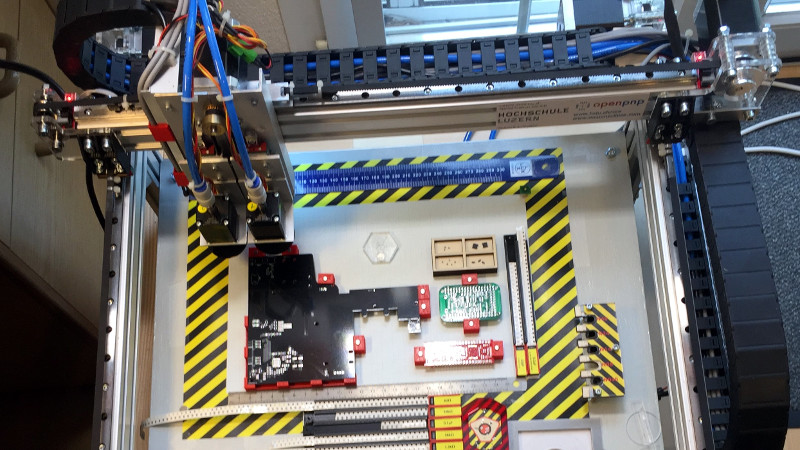It’s a Holy Grail among hackerspaces, the possession of a pick-and-place machine. These robotic helpers for placing surface-mount components on PCBs are something of a gateway to electronic production, but they can carry a fearsome cost. Happily for the cash-strapped would-be electronic manufacturer, it is possible to build a pick-and-place for yourself. [Mcuoneclipse] has demonstrated this with a rather impressive build that works with the freely available OpenPnP software.
Superficially it shares much with what you might expect from a small CNC mill, in that it has a frame made from extruded aluminium that carries rails that trace an X and a Y axis supporting a tool head. But instead of a blade it has a box made from laser-cut ply that contains a camera and a vacuum pick-up tool that can collect a component from the tapes and deposit it in the correct point on the board. At the machine’s heart is a Smoothieboard, and the work is done by an assortment of solenoid valves and actuators. A huge amount of attention to detail has been paid to this build, with a holder for all the interchangeable nozzles for different component sizes, laser-cut mountings for all the motorised components, and automatic feeders for the SMD tapes all being carefully designed and built. Several iterations of the design are presented, in particular around the head itself which has passed through more than one form to remove as much vibration as possible. But don’t take it from us, have a look at the video we’ve pasted in below the break.
This isn’t the first pick-and-place machine we’ve brought you here at Hackaday. If you already have a 3D printer, would you consider this upgrade?
Thanks [Drew Fustini] for the tip.
















Definately interesting and impressive. I just wonder where you draw the line between complete manual assembly, semi-professional inhouse manufacturing with “DIY” automation solutions and just go the easy route and select one of the many EMS providers out there that can handle everything on a professional production line. From paste printing, component placement, soldering, down to AOI and X-Ray inspection and even in circuit testing and programming, if needed…
The referred article (https://mcuoneclipse.com/2018/06/26/building-a-diy-smt-pickplace-machine-with-openpnp/) has a link to a presentation I gave at the Embedded Computing Conference 2018 (https://mcuoneclipse.files.wordpress.com/2018/06/ecc18-styger-pickandplace-mit-openpnp.pdf, sorry in German) which draws the line around 50 boards (this depends as well of the number of components on the boards). For some it makes sense to have such machine for boards in the range of 5 – 50. My experience is that such a DIY machine and being familiar with all the setup it already is worthwile to use for a single board. In essence such a machine does not replace external EMS providers, but helps with board builds you would do otherwise manually. Plus there is the time and cost saving aspect too.
Thanks for the reply, Erich. I’ll go check it out. German is not a problem at all, i’m from Switzerland ;).
For my needs, i’d probably still prefer to go for a more professional machine, like the TVM802B mentioned in other replies over a DIY build. Around 4’500$ with 46 feeders seems to be a pretty reasonable price and should handle most simpler boards with one pass. It’s still lightyears away from the Siplace machines our EMS provider uses in his production lines tho, but hey, they pick and place around 500 million components per year, so they better do it a little bit faster…
just looking at the picture screamed slow, and video didnt disappoint, 600 PPH?
I think the fact it works is really impressive, as our team ended up choosing a TVM802B after the OpenPnP project build costs began to balloon.
I wouldn’t complain about speed, as the machine vision would need some processing power for higher frame-rates.
;-)
I Have been drooling over the TVM802B for some time.. Its surprisingly affordable. ^_^
https://www.youtube.com/watch?v=VsGQ3Gwg9xQ&t=187s
Why do you think the picture “screames slow” ?
The machine is hardly shown moving at all and probably moving at 10% or less of what it is capable off.
Lot’s of reasonably fast timing belt driven machines are available and some are quite fast, but the fastest have wider timing belts for stiffness and bigger motors.
I also like the idea of a single timing belt and motor for 2 vacuum pickups, which should be able to speed the machine up significantly compared to a single vacuum pickup.
A silly thing that would be easy to improve is that the components are lowered above the camera for focussing ???
I’m also wondering how long the laser cut wood and 3d printed plastic parts last. Some of them look quite fragile.
This machine is kind of cool if you like to assemble simple pcb’s for fun.